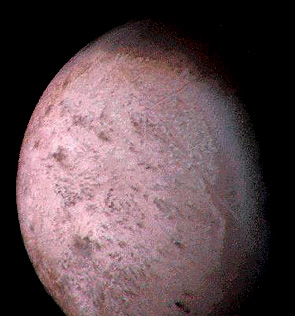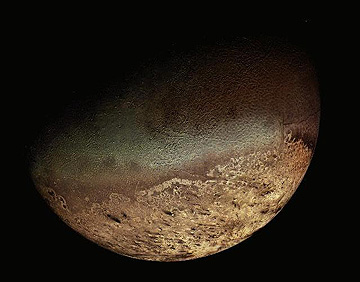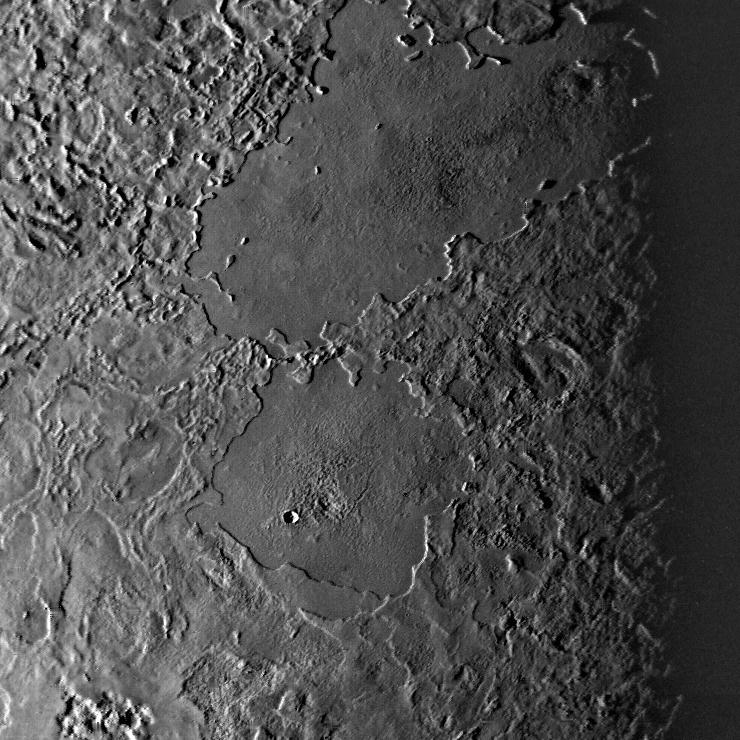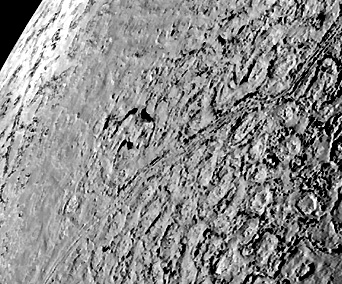Remote Sensing Tutorial Page 19-21¶
Contents
Neptune is the farthest out of the major planets. Much like Uranus in appearance, it too is mostly hydrogen with some helium. High winds periodically produce storms that appear as dark spots. Voyager 2 found 5 new, small satellites. But, the real interest resulting from the Voyager passage is the very large (2400 km) satellite Triton, which seem an agglomerate of rock and frozen hydrogen and methane, with subordinate, perhaps trivial, amounts of water. Its southern polar cap has a melange of light and dark deposits of different compositions (and origins?).
Neptune has six small satellites, irregular in shape and mostly rock. One, Triton, that is farthest out and much larger (2,700 km [1,678 mi] in diameter) than the others, is one of the most intriguing bodies - planets or satellites - in the Solar System. Triton moves in a retrograde circular orbit, i.e., it moves in a clockwise direction (looking down from north) compared to the counterclockwise rotation of Neptune and its other satellites. Triton’s axis of rotation tilts 157° relative to its parent’s axis. We cite these unusual conditions as evidence, either of its capture or of its assembly after a collision, possibly influenced by interactions with Pluto as that small body periodically orbits inside Neptune’s orbit.
The full view (left) of Triton reveals it is very different from most of the giant planets’ satellites. This satellite has a brownish pink color, has a polar cap (right), and a structured surface. The color may be due to frozen nitrogen and/or the effects of methane.
` <>`__19-71: Compare the atmospheric properties of Triton with those of Titan. `ANSWER <Sect19_answers.html#19-71>`__
The south polar ice cap appears mottled, with dark areas perhaps showing rocks exposed along wind streaks where gases have sublimed:
What has been interpreted as erupting nitrogen gas from structures or fissures made of frozen nitrogen and rock has been called “ice volcanoes” in which liquid nitrogen and/or methane vaporizes in plumes or geyser-like jets at the surface, carrying along particulates that form deposits on the ice cap. Ice “lavas” composed of water ice and some ammonia and methane produce flow features on the surface as well. Here is an area which contains this phenomenon - again the first of its kind in the Solar System. :
|Color version of part of the south polar ice field, in which some so-called |
Triton’s surface contains ridges, fault valleys, and occasional impact craters. This image shows a broad circular feature, with somewhat scalloped edges, that may be some strange volcanic caldera or a distorted impact crater (or one of each).
This computer-generated perspective view helps to visualize this terrain:
Major fracture systems occur over much of Triton, especially in the equatorial regions. Some of the grabens are hundreds of kilometers long.
Terrains on Triton involving fracturing can take on a peculiar “texture” similar to the surface of a cantaloupe (top) or appearing as a series of oval features controlled by ridges (bottom):
While filled grabens (fracture-bounded depressions) are a factor in canteloupe terrains, their specific origin remains unsettled. The oval features are even more mysterious.
` <>`__19-72: Many of the individual roundish features making up the canteloupe texture look like distorted impact craters. What argues against this possible identity? `ANSWER <Sect19_answers.html#19-72>`__
Nereid, an irregular shaped satellite (maximum dimension = 300 km [200 miles] that is the outermost of the group, had been observed by telescope from Earth. Voyager 2 also got pictures but Nereid being far away at the time, these are fuzzy:
Largest (418 km; 261 miles) of the six satellites discovered by Voyager is the nearly round Proteus (below). Although bigger than Nereid, it remained undetected by Neptune because it was too close to the planet’s surface and was masked by neptunian light.
The last planet in our solar system, Pluto, is not much different in diameter (about 2,340 km [1,454 mi]) than Triton. No space probe has visited it yet, although NASA has proposed one (Pluto Express) for early in the 21st Century (but on hold, since Congress has not authorized funding). First discovered (though its existence had been predicted) in 1930, by Dr. Clyde Tombaugh, through the large telescope at the Lowell Observatory in Flagstaff, AZ, the best pictures (from HST) today show it is a mix of very dark (organic?) and light zones of unknown nature. Its density suggests mostly rock with some ices (nitrogen, methane, and water), from which an extremely tenuous atmosphere has evaporated.
Pluto’s orbit is so eccentric that at times its path lies inside Neptune’s. Its orbital period is 1.5 times that of Neptune, with which it locks in a 3:2 resonance. Pluto has a relatively large satellite, Charon, whose diameter (1,260 km [783 mi]) makes it just half the size of its parent (one opinion considers the two to be a double planet system), with which it is in synchronous rotation.







